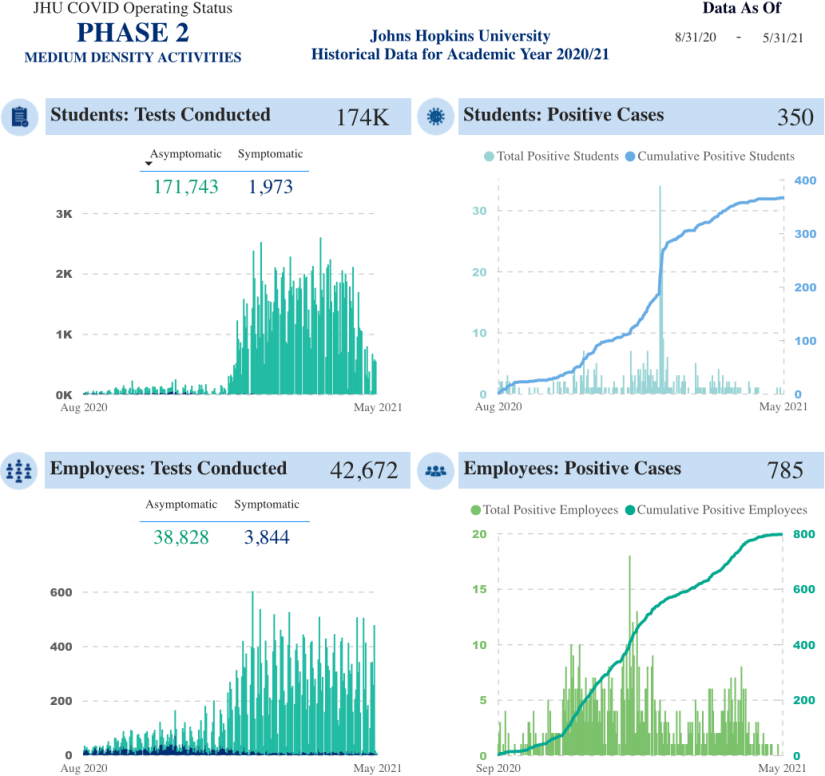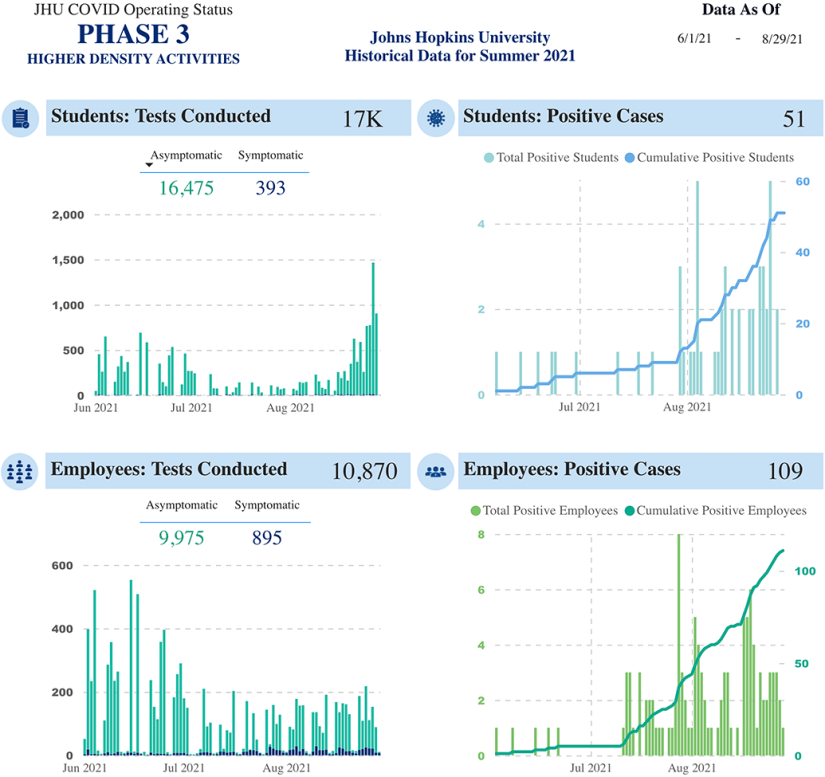Historical COVID-19 Testing Data
Summer 2022 | Academic Year 2021-2022 | Academic Year 2020-2021 | Summer 2021 | Information and Definitions
Data for Summer 2022
The data below shows the cumulative counts for positive cases for August 2022 – June 2021. These data are static counts.

Data for Academic Year 2021 – 2022
The data below shows the cumulative counts for positive cases for August 2020 – May 2021. These data are static counts.

Data for Academic Year 2020 – 2021
The data below shows the cumulative counts for positive cases for August 2020 – May 2021. These data are static counts.

Data for Summer 2021
The data below shows the cumulative counts for positive cases for June – July 2021. These data are static counts.

Additional information and definitions
Positive Cases: The number of individuals within the Johns Hopkins University community who have tested positive for COVID-19. Student data includes undergraduates, graduate students, and medical students. Post-doctoral fellows, medical residents and clinical fellows, and medical house staff are included in the employee counts. Johns Hopkins Health System (including Johns Hopkins Hospital) employees are not represented in these counts. The data displayed on the dashboard correspond to date of test result and not date of sample collection.
Tests Conducted: This includes: 1) tests conducted by Johns Hopkins University for asymptomatic (i.e., no symptoms of COVID-19) students and employees; and 2) tests conducted by Johns Hopkins University for students and employees experiencing symptoms associated with COVID-19. The asymptomatic testing program was significantly expanded in January 2021.
Cumulative Tests Conducted: The total number of COVID-19 tests conducted at Johns Hopkins University since Aug. 31, 2020. Student data includes undergraduates, graduate students, and medical students. Post-doctoral fellows, medical residents and clinical fellows, and medical house staff are included in the employee counts. Johns Hopkins Health System (including Johns Hopkins Hospital) employees are not represented in these counts.
Test Turnaround Time: The time from sample collection until determination of a test result. Within Johns Hopkins University, turnaround time for test results is typically 24 hours.
Testing Frequency: Starting in January 2021, asymptomatic testing became widely available. Undergraduates living in Johns Hopkins residential housing and off-campus in the Baltimore area are required to be tested twice per week. The frequency of required undergraduate testing may be increased as needed. Asymptomatic faculty, staff, and graduate students who are student-facing or otherwise identified by their school were required to be tested at least once weekly until August 2022. All others may have voluntary weekly testing.
Isolation Housing: Rooms in residential halls and other facilities set aside by Johns Hopkins University for students who test positive for COVID-19. Available housing may be used for either isolation or quarantine.
Quarantine Housing: Rooms in residential halls and other facilities set aside by Johns Hopkins University for students living in Johns Hopkins housing who have had meaningful contact with a person who tested positive for COVID-19. Available housing may be used for either isolation or quarantine.
JHU COVID-19 Operating Status: Johns Hopkins University uses a three-phase operating status:
- Phase 1: Resuming low-density activities
- Continue to comply with strict physical distancing and appropriate mask requirements
- Testing and contact tracing of symptomatic students and employees
- Phase 2: Resuming medium-density activities
- Continued reliance on strict physical distancing and appropriate masking requirements
- Testing and contact tracing of all symptomatic students and employees, and asymptomatic individuals at a rate similar or better than national, state, and local efforts
- Phase 3: Resuming higher-density activities
- Requires widely available vaccine, effective therapeutics, and/or substantial immunity among community
Positivity: Test positivity rates are a metric used to help public health officials determine whether their state or county is testing enough of its population for the size of its epidemic. Importantly, positivity is a measure of testing capacity, and can be used to inform our interpretation of case trends. It is not a measure of how prevalent a disease is in a community. Because the Johns Hopkins fall 2020 approach to testing was based on a more limited testing program—twice-weekly asymptomatic testing of a small number of students living on campus and participants in an epidemiological surveillance study as well as medical management testing of symptomatic individuals—the positivity rate would not have the same relevance as it would for state or local health departments. The university will revisit publishing a positivity rate in spring 2021.





